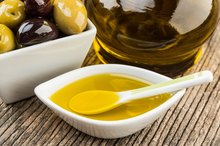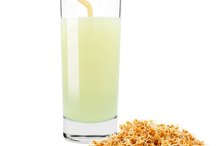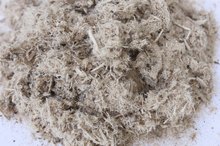What does fact checked mean?
At Healthfully, we strive to deliver objective content that is accurate and up-to-date. Our team periodically reviews articles in order to ensure content quality. The sources cited below consist of evidence from peer-reviewed journals, prominent medical organizations, academic associations, and government data.
The information contained on this site is for informational purposes only, and should not be used as a substitute for the advice of a professional health care provider. Please check with the appropriate physician regarding health questions and concerns. Although we strive to deliver accurate and up-to-date information, no guarantee to that effect is made.
Kombucha Vs. Rejuvelac
Kombucha and rejuvelac are both fermented drinks with purported health benefits 12. However, both drinks have distinct differences in preparation. One is made from a culture of yeasts and bacteria, while the other is made from grains such as spelt. Proponents of each drink tout health benefits, but no clinical studies support these claims. You should consult your doctor before drinking kombucha or rejuvelac 2.
Kombucha
Proponents call kombucha a "wonder drink" and promote it as a cure-all to boost energy, metabolism and immune function, and even as a cancer cure 2. It is commonly known as mushroom tea, but it does not come from a mushroom. Kombucha is made by adding sugar and tea to a culture of yeast and bacteria 2. The culture is called a mushroom because it is gray in color and shaped like a pancake. After allowing the mixture to ferment, the resulting drink contains B vitamins. It also contains acidic compounds such as acetic acid and ethyl acetate.
- Proponents call kombucha a "wonder drink" and promote it as a cure-all to boost energy, metabolism and immune function, and even as a cancer cure 2.
- The culture is called a mushroom because it is gray in color and shaped like a pancake.
Rejuvelac
Can Pregnant Women Drink Apple Cider?
Learn More
Proponents say rejuvelac aids digestion and reduces inflammation. Rejuvelac is a fermented drink, but it is make differently from kombucha 2. Rejuvelac is typically made by fermenting spelt, rye or wheat berries in water for about three days, according to Judita Wignall in her book, "Going Raw." The resulting liquid contains beneficial bacteria known as probiotics, which aid digestion, according to Wignall. You can find a wide variety of rejuvelac recipes -- either ready-made or make-your-own -- at health food stores.
- Proponents say rejuvelac aids digestion and reduces inflammation.
- Rejuvelac is typically made by fermenting spelt, rye or wheat berries in water for about three days, according to Judita Wignall in her book, "Going Raw."
Toxicity
Toxins such as fungi can contaminate kombucha, which can cause illnesses, according to MayoClinic.com 2. Severe illness has been reported from high acid levels, including a report of one death, after drinking kombucha 2. Due to its capacity for toxicity, it is no longer considered safe, according to Drugs.com 2. Rejuvelac is not known to cause illness, with no reports of toxicity associated with drinking rejuvelac.
Precautions
How Many Calories Are in Malt Liquor?
Learn More
You should keep in mind that dietary supplements are not required to undergo safety testing and that all supplements have the capacity to cause side effects. Other than toxicity, kombucha's side effects have not been thoroughly studied, and any rejuvelac side effects have not been documented as of October 2011 2. If you choose to make or purchase kombucha or rejuvelac, you should only do so after discussing it with your doctor 2.
Related Articles
References
- MayoClinic.com: What is Kombucha Tea and Does it Have Health Benefits?
- Drugs.com: Kombucha
- Going Raw; Everything You Need to Start Your Own Raw Food Diet and Lifestyle Revolution at Home; Judith Wignall
- U.S. Department of Agriculture: Agricultural Research Service. FoodData Central. 2019.
- Kapp JM, Sumner W. Kombucha: a systematic review of the empirical evidence of human health benefit. Ann Epidemiol. 2019;30:66-70. doi:10.1016/j.annepidem.2018.11.001
- Marsh AJ, O'sullivan O, Hill C, Ross RP, Cotter PD. Sequence-based analysis of the bacterial and fungal compositions of multiple kombucha (tea fungus) samples. Food Microbiol. 2014;38:171-8. doi:10.1016/j.fm.2013.09.003
- Bhattacharya D, Ghosh D, Bhattacharya S, et al. Antibacterial activity of polyphenolic fraction of Kombucha against Vibrio cholerae: targeting cell membrane. Lett Appl Microbiol. 2018;66(2):145-152. doi:10.1111/lam.12829
- Martínez Leal J, Valenzuela Suárez L, Jayabalan R, Huerta Oros J, Escalante-Aburto A. A review on health benefits of kombucha nutritional compounds and metabolites. CyTA - Journal of Food. 2018;16(1):390-399. doi:10.1080/19476337.2017.1410499
- Colorado State University Department of Food Science & Human Nutrition. Understanding and making kombucha.
- Memorial Sloan Kettering Cancer Center. Kombucha. Updated November 27, 2019.
Writer Bio
Janet Renee is a clinical dietitian with a special interest in weight management, sports dietetics, medical nutrition therapy and diet trends. She earned her Master of Science in nutrition from the University of Chicago and has contributed to health and wellness magazines, including Prevention, Self, Shape and Cooking Light.









